May 23rd, 2025 / by Prestige Law Personal Injury & Car Accident Lawyers - Category Personal Injuries
Who’s Liable for a Sidewalk Injury in California?
A simple walk down the street can take an unexpected turn if you trip on a cracked or uneven sidewalk. What might seem like a minor incident can lead to serious injuries, costly medical bills, and lasting complications.
That’s where California’s sidewalk rule comes in. This legal principle helps determine who’s responsible for keeping sidewalks safe—and whether you may be entitled to compensation if you’re hurt.
In many cities, sidewalk maintenance isn’t just the city’s job. Homeowners, businesses, or other adjacent property owners may be legally obligated to fix hazards in front of their properties.
Understanding how the sidewalk rule works is the first step to protecting your rights after an accident—and holding the correct party accountable.
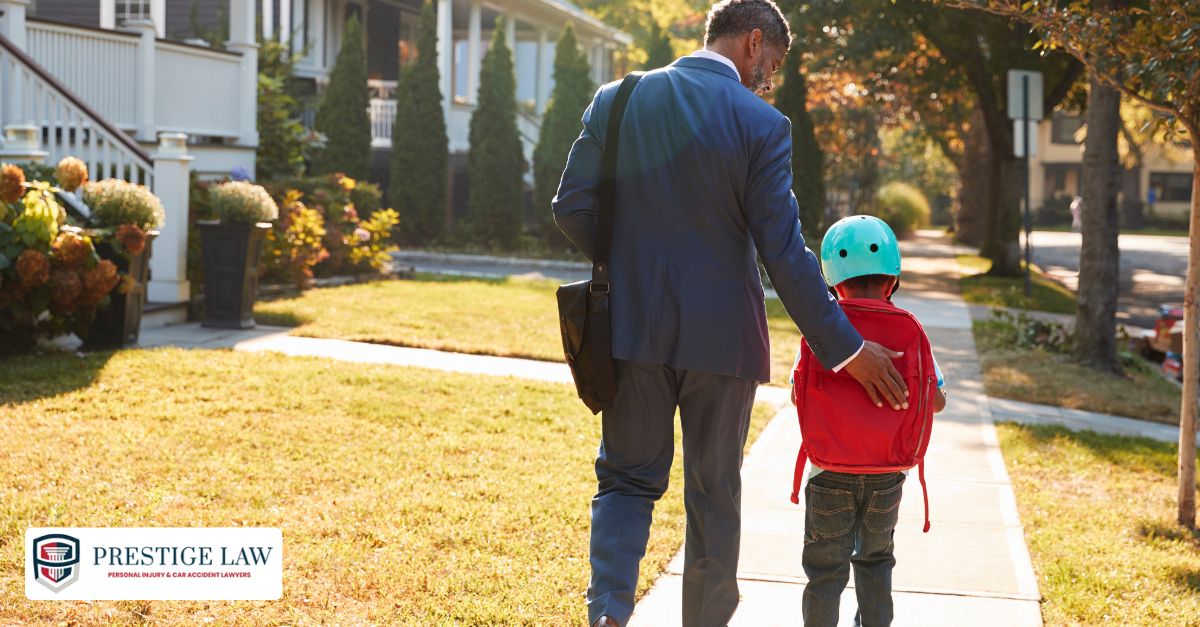
What is the sidewalk rule?
The sidewalk rule is a legal principle that determines who is responsible for maintaining sidewalks—and who may be held liable if someone is injured due to unsafe conditions.
While sidewalks are often publicly owned, many California cities place the legal duty of upkeep on the adjacent property owner. That includes homeowners, commercial tenants, or business owners, depending on the local ordinance.
The rule becomes critical when someone trips, slips, or falls due to issues like:
- Cracked or uneven pavement
- Tree root damage
- Debris or obstructions
- Poor lighting or water drainage
If the person or entity responsible for the sidewalk knew—or should have known—about the hazard and failed to address it, they may be legally liable for any injuries that result.
This doctrine plays a central role in pedestrian injury law by clarifying whether responsibility lies with the city, a private party, or both.
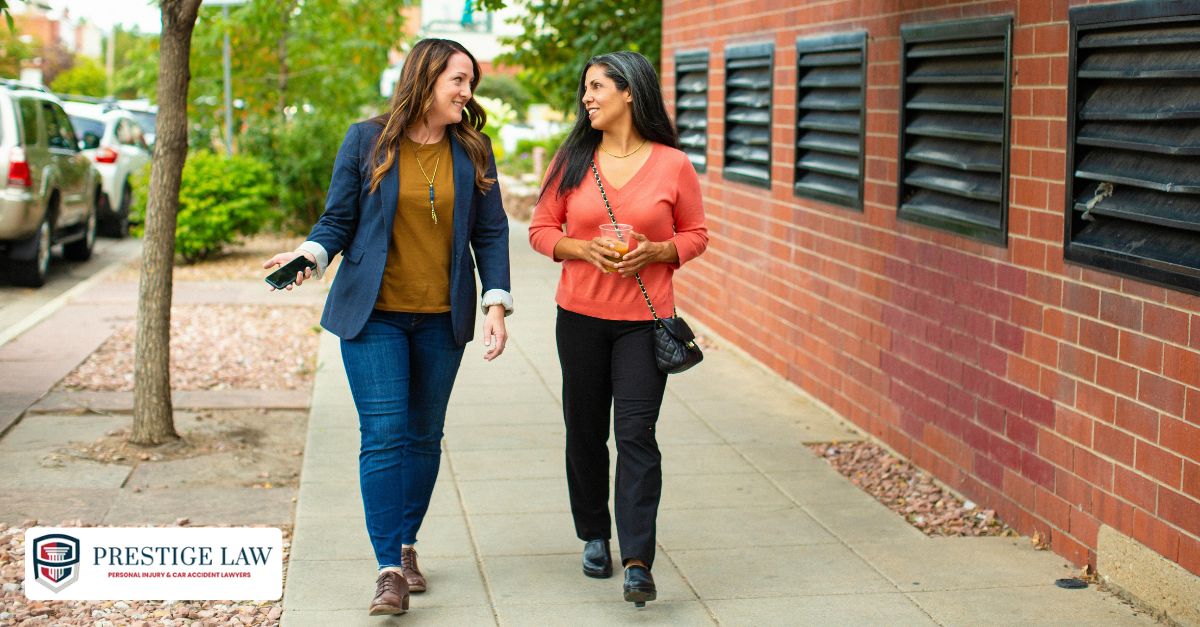
Sidewalk Rights as a Pedestrian
In California, pedestrians have the legal right to use sidewalks without the threat of vehicle-related hazards. Drivers are expected to yield to pedestrians and avoid blocking or crossing sidewalks unless absolutely necessary.
Several sections of the California Vehicle Code (CVC) protect pedestrian rights in sidewalk zones:
- CVC 555: Designates sidewalks for pedestrian use only.
- CVC 21663: Prohibits motor vehicles from using sidewalks, except when entering or exiting adjacent properties.
- CVC 21952: Requires drivers crossing a sidewalk to yield to any pedestrians present.
- CVC 21956: In areas without sidewalks, pedestrians must walk along the left edge of the roadway, facing traffic.
These laws aim to prevent curbside collisions and ensure pedestrians can walk safely, even in areas where infrastructure is lacking.
When a driver violates these rules and causes injury or death, the legal consequences can be serious. In such cases, legal claims may fall under pedestrian accidents, opening the door to compensation for medical bills, lost wages, and more.
Who is responsible for sidewalk maintenance?
Liability for sidewalk injuries in California isn’t always clear. Depending on where the accident occurs, the responsible party may be a private property owner, a public agency, or even a third party like a contractor. Local ordinances and state statutes determine who must maintain which sidewalks—and who can be held legally accountable.
Property Owners and Their Legal Duties
California’s Streets and Highways Code Section 5610 allows cities to shift sidewalk maintenance duties to nearby property owners. While sidewalks are technically public property, many municipalities require homeowners and businesses to keep the adjacent walkway in safe condition.
That includes fixing uneven slabs, addressing root damage, and removing obstructions. If a property owner knew—or reasonably should have known—about a hazard and failed to fix it, they could be liable under premises liability law.
However, not all sidewalk defects qualify. Courts often distinguish between “trivial” and “dangerous” conditions. Generally, cracks or elevation changes greater than one inch are considered legally actionable.
Government Entities and Sidewalk Liability
Under California Government Code Section 835, a city or other public entity can be held liable if:
- The sidewalk posed a foreseeable risk of injury
- The agency had actual or constructive notice of the danger
- No reasonable steps were taken to fix it
Filing a claim against a government entity involves strict timelines. In most cases, you must file a formal notice of claim within six months of the injury. If that deadline passes, your legal options may be limited—even if the city was clearly at fault.
How Local Ordinances Impact Responsibility
Different California cities handle sidewalk maintenance differently. Some, like Los Angeles and San Francisco, assign responsibility directly to adjacent property owners through municipal codes. Others provide city-managed maintenance but later bill homeowners for the repairs.
This patchwork of local rules makes sidewalk injury cases complex. An experienced lawyer must review city ordinances, ownership records, and maintenance logs to identify who’s responsible—and whether the hazard meets legal standards for a claim.
Other Potentially Liable Parties
While property owners and government agencies are the most common defendants in sidewalk injury claims, liability can also extend to third parties whose actions contributed to unsafe conditions.
These parties may include:
- Contractors who performed negligent or incomplete sidewalk repairs
- Landscape designers whose plans resulted in poor grading or visibility
- Utility companies that left pavement uneven after completing underground work
Identifying all potentially responsible parties is essential in a sidewalk injury case. Missing a liable party—especially one with deeper resources or clearer legal exposure—can weaken a claim or reduce compensation.
An experienced attorney can help investigate the accident site, review permits, and gather evidence to ensure that all at-fault parties are included in your legal strategy.
Why Clarity on Responsibility Matters
When sidewalk injuries happen, unclear responsibility can delay or derail compensation. If it’s not immediately clear whether the city, a property owner, or another party is at fault, injured pedestrians may not know where to file a claim—or may miss critical legal deadlines while sorting it out.
That’s why working with a lawyer is so important. An experienced attorney can:
- Review local ordinances and maintenance responsibilities
- Determine who controlled or owned the hazardous area
- Investigate the timeline of the defect and whether proper notice existed
- Ensure government deadlines (like the six-month claims period) are met
- Build a strong case for full financial recovery
At Prestige Law Firm, our attorneys have extensive experience handling sidewalk-related claims throughout California. We understand how to cut through red tape, identify liable parties, and pursue maximum compensation for medical expenses, lost wages, and long-term recovery needs.
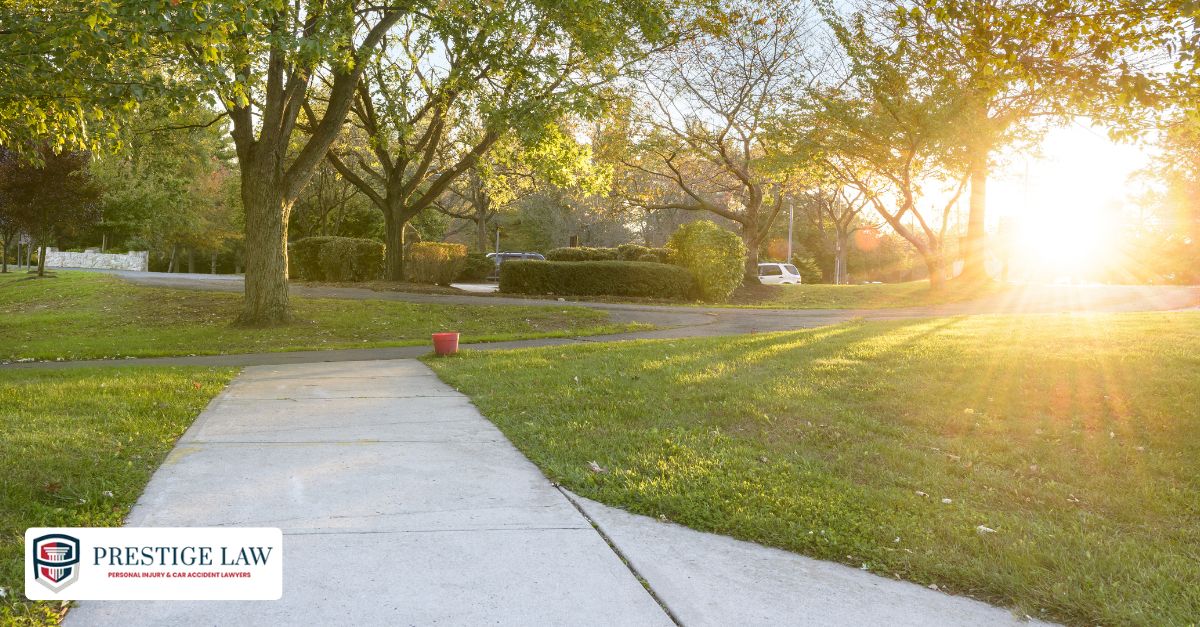
Common Causes of Sidewalk Accidents
Sidewalk accidents often happen because of poor maintenance, environmental conditions, or flawed design—sometimes involving more than one issue at once. The most common hazards include:
- Cracks, potholes, or uneven pavement: Often caused by aging concrete or tree root growth, these surface defects are among the top reasons for trip-and-fall claims.
- Obstructions: Trash bins, parked vehicles, or construction debris can block walkways and force pedestrians into dangerous areas.
- Environmental factors: Overgrown vegetation, poor drainage, or accumulated leaves can create slippery or unstable conditions.
- Design flaws: Inadequate lighting, steep grading, or violations of ADA accessibility standards can make sidewalks unsafe—especially at night or for older adults.
These issues highlight the importance of regular inspection and timely maintenance. When preventable hazards cause injury, California law allows injured pedestrians to pursue compensation for medical expenses, pain and suffering, and lost wages.
Sidewalk Rule in Personal Injury Cases
The sidewalk rule plays a central role in personal injury claims involving trip-and-fall or slip-and-fall accidents. If you’re hurt because of unsafe sidewalk conditions—such as cracked concrete, uneven slabs, or poor drainage—your legal case depends on proving that someone failed in their duty to keep the area safe.
To hold a property owner or city liable, you must show that:
- They were responsible for maintaining the sidewalk
- The condition was dangerous, not trivial (usually over one inch in height or depth)
- They knew or should have known about the hazard
- They failed to take reasonable steps to fix it
The timeline of notice—how long the defect existed—and the severity of the hazard are both critical. Courts examine whether a “reasonable person” in the same situation would have repaired or warned about the danger.
These claims can be won, but only if evidence is collected early and clearly tied to the responsible party.
What to Do After a Sidewalk Injury
If you’re hurt because of a hazardous sidewalk, what you do next matters. Acting quickly not only supports your recovery—it also protects your legal case. Here are the most important steps:
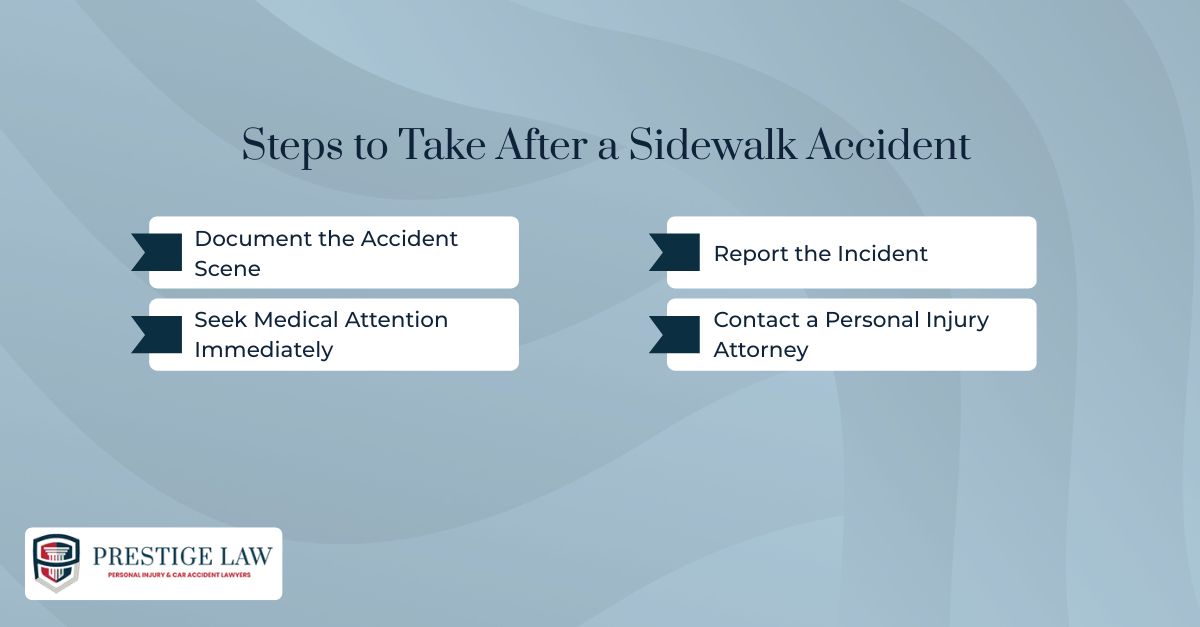
Document the Accident Scene
Use your phone to take wide and close-up photos of the hazard. Focus on conditions like:
- Cracks, uneven pavement, or potholes
- Tree root damage
- Obstructions, debris, or poor lighting
- Slippery or water-damaged surfaces
If anyone saw the incident, ask for their name and contact info. Witnesses can provide valuable third-party accounts.
Also notify the adjacent property owner or the city as soon as possible so an official record exists. This notice can be important later when establishing liability.
Seek Medical Attention Immediately
Even if your injuries feel minor, don’t delay care. See a doctor right away so your symptoms are properly documented.
Medical records from the date of the accident can make or break a personal injury case. California’s statute of limitations is generally two years, but public entity cases often require notice within just six months.
Report the Incident
Filing a formal report strengthens your case. If the sidewalk is city-owned, report the hazard to the appropriate department. If it’s in front of a private business or home, notify the owner in writing or by email if possible.
For injuries on government property, be aware: the six-month deadline to file a claim starts from the date of the injury. Missing it can eliminate your right to seek compensation.
Contact a Personal Injury Attorney
Sidewalk injury claims can be complicated—especially if responsibility is shared between a city, property owner, or third party. Because California uses comparative negligence rules, even if you were partially at fault (like texting while walking), you may still qualify for compensation.
An experienced lawyer can help:
- Investigate ownership and maintenance history
- Preserve critical evidence
- File your claim before the deadline
- Negotiate with public and private insurers
If you’ve been injured in a sidewalk accident, don’t navigate it alone. Contact Prestige Law Firm for a free consultation. We’ll help you understand your legal options and protect your rights.
Sidewalk Rule and Vehicle-Related Accidents
Although the sidewalk rule typically applies to injuries caused by hazardous walking conditions, it can also intersect with traffic-related incidents—especially when sidewalk design, blockage, or neglect contributes to a pedestrian’s exposure to traffic.
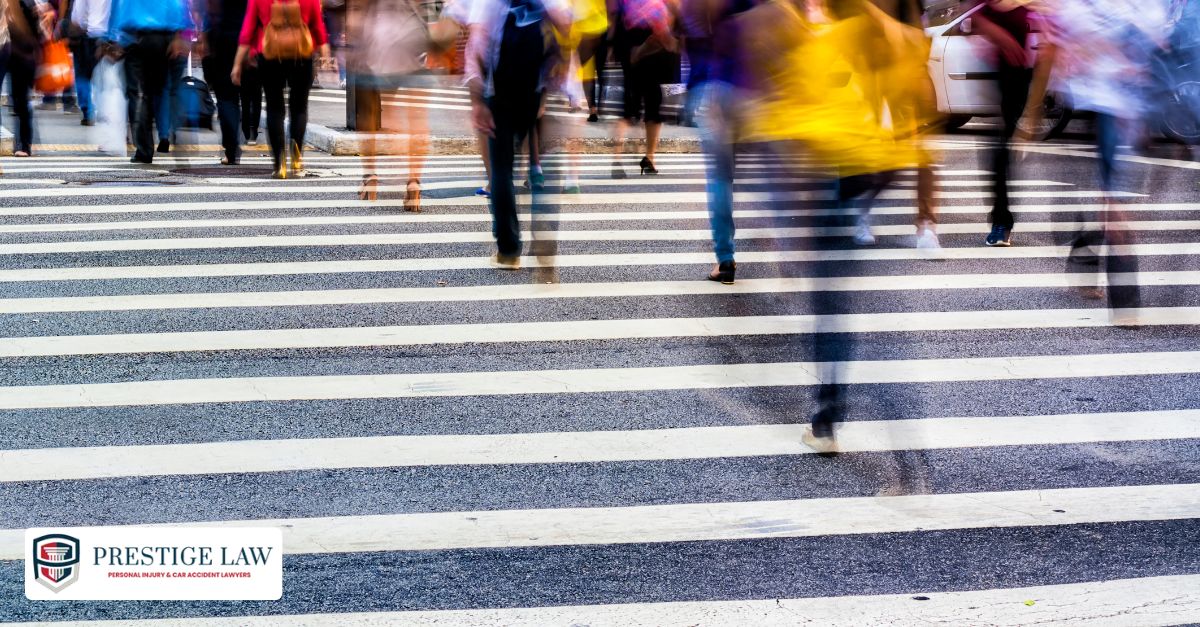
Jaywalking and Unsafe Crossings
California’s Freedom to Walk Act (AB 2147) relaxed enforcement of jaywalking laws, but pedestrians are still expected to exercise reasonable care. Crossing mid-block or outside a crosswalk may not get you ticketed—but it can affect your claim if you’re injured.
If a pedestrian is hit while crossing unsafely, California’s comparative negligence laws may reduce compensation based on shared fault.
Curbside and Roadside Collisions
In areas without sidewalks—or where sidewalks are blocked—pedestrians may be forced to walk along the road. If they’re hit by a vehicle in these conditions, fault may extend beyond the driver.
For example:
- A city could be liable for failing to provide safe pedestrian infrastructure
- A property owner might be responsible for blocking access to the sidewalk
- A driver who was speeding or distracted may still carry partial or full liability
These incidents often fall under broader car accidents law but are made more complex when sidewalk hazards play a role in pushing pedestrians into traffic.
When Sidewalk Conditions Lead to Serious Accidents
If poor sidewalk maintenance directly contributes to a pedestrian being hit, the responsible party may still be held liable—even if a vehicle caused the final injury. That’s why it’s important to investigate all contributing factors.
How the Sidewalk Rule Impacts Auto Accident Claims
In some pedestrian-vehicle accidents, defective sidewalks play a direct role—even if a driver was involved. When sidewalk conditions force pedestrians into traffic or block safe walking paths, liability may extend beyond the driver alone.
For example:
- A city may be liable for failing to repair broken sidewalks that caused a pedestrian to step into the road
- A property owner may be responsible for leaving debris or construction materials that blocked access to the sidewalk
- A contractor could share fault for poor grading or incomplete repairs that created unsafe detours
In these situations, sidewalk maintenance failures intersect with traditional traffic law, making claims more complex. Legal investigations often need to explore shared liability among municipalities, private property owners, and drivers.
Though rare, some of these incidents result in fatal injuries—especially for older adults or medically vulnerable pedestrians. When a hazardous sidewalk condition leads to a death, California’s wrongful death laws allow surviving family members to file a claim for compensation. This can include funeral costs, loss of companionship, and the deceased’s financial contributions.
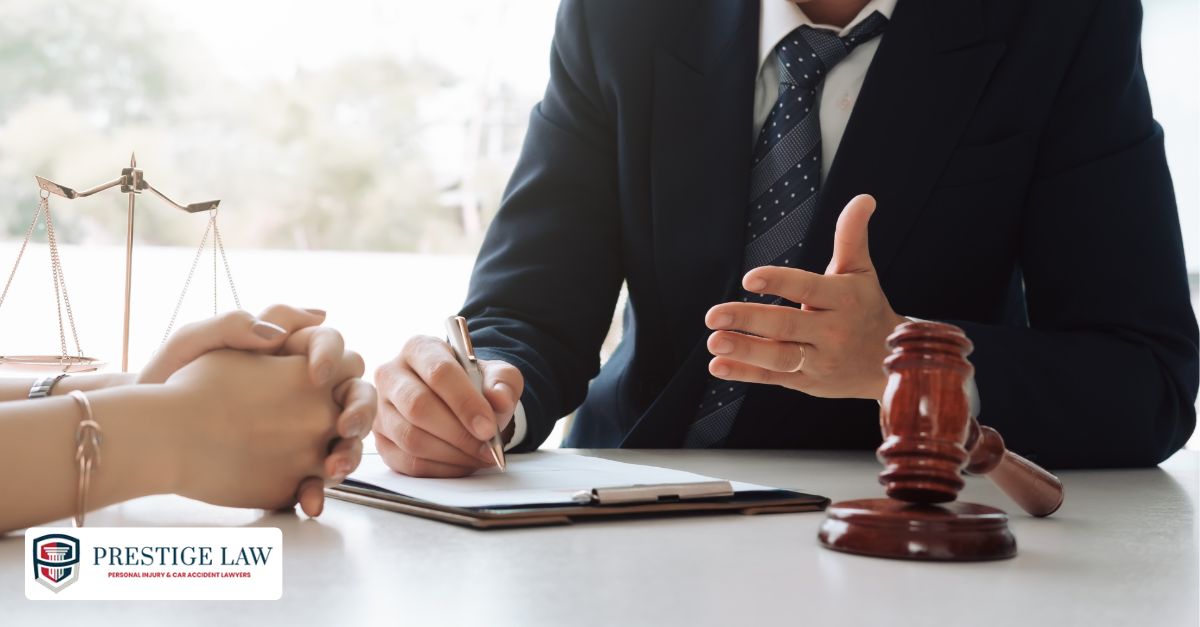
How Prestige Law Can Help
If you’ve been injured due to a dangerous sidewalk or unsafe pedestrian conditions, Prestige Law Firm, P.C. can help you navigate the legal process with clarity and confidence.
Led by founding attorney Paul Aghabala, our California-based boutique firm focuses exclusively on personal injury law, including sidewalk accidents, pedestrian injuries, and premises liability claims. With over two decades of experience, we understand how to handle complex cases involving city ordinances, public entity claims, and comparative fault.
When you work with us, you’ll speak directly with an attorney—never just staff or case handlers. We handle each claim with care, urgency, and strategy, from investigation to final settlement.
Our legal process includes:
- Investigating the hazard and identifying all liable parties
- Coordinating your medical care with trusted providers
- Gathering documentation and evidence
- Filing and negotiating claims with insurers and government entities
- Preparing for litigation if a fair settlement isn’t offered
We understand how disruptive a sidewalk injury can be—and we’re here to help reduce the stress. Not sure what working with us looks like? Visit our legal process overview to learn what to expect.
To speak with an attorney, contact us online or call (818) 424-4620 for a free consultation.
Conclusion
Sidewalk injuries can happen quickly—but the legal questions they raise are anything but simple. From unclear maintenance duties to mixed liability between property owners and public agencies, California’s sidewalk rule plays a key role in determining who should be held accountable.
Whether the hazard involved cracked pavement, poor lighting, or a blocked path, you may be entitled to compensation if someone else’s negligence contributed to your fall or injury. These cases depend on prompt documentation, a clear understanding of local ordinances, and meeting strict legal deadlines—especially when public entities are involved.
At Prestige Law Firm, we’ve helped clients pursue claims involving a wide range of pedestrian accidents, including those caused by sidewalk hazards, unsafe infrastructure, and vehicle-pedestrian interactions. We’re here to help you move forward with clarity and confidence.
FAQs
Can I sue for falling on a sidewalk?
Yes, if your fall was caused by a hazardous condition like a large crack, uneven pavement, or poor lighting. You must show that the responsible party—such as a property owner or city—was negligent in maintaining the sidewalk.
Is the city responsible for sidewalk injuries?
Sometimes. In many California cities, property owners are responsible for sidewalk maintenance, but in others, the city may bear that duty. It depends on the local ordinance and who had control over the area.
How do I prove negligence in a trip-and-fall case?
You’ll need to show that the hazard was dangerous, that someone knew or should have known about it, and that they failed to fix it. Evidence like photos, medical records, and witness statements can help build your case.
What should I do if I trip on a cracked sidewalk?
Get medical attention right away, take photos of the hazard, and report the incident to the property owner or city. Then, speak with a personal injury attorney to understand your options and protect your claim.
